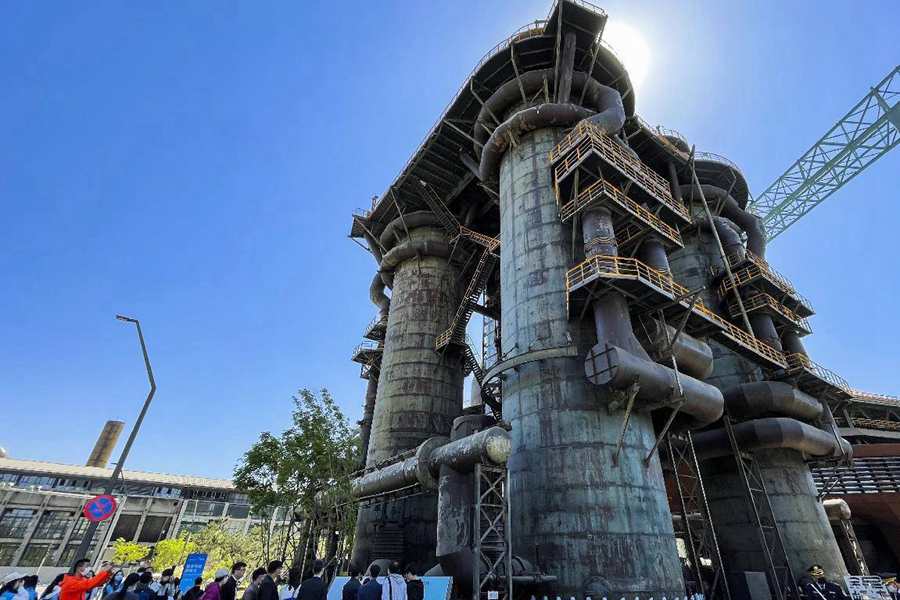Industrial heritage in China gains new vigor
Shougang Park, the century-old former production premises of Chinese steelmaker Shougang Group in Shijingshan district of Beijing, is now a famous cultural and sports complex that enjoys increasing popularity.
Many tourists have been attracted to the special park, which has crisscross footpaths and ingenious landscape designs, and more importantly, a magnificent newly-built large ski-jumping platform, one of the venues for the Beijing 2022 Olympic and Paralympic Winter Games.
The raw material area of the old plant has been transformed into the work site of the Beijing Organising Committee for the 2022 Olympic and Paralympic Winter Games, while the past clean coal workshops have become the training field of China’s national ice and snow sports teams.
Besides the old production premises of Shougang Group, many other old industrial sites, including factories, mines, and industrial areas, have gradually fallen into decay and become industrial heritage with the passing of time.
Since industrial heritage mirrors the history of technology and industry and is of important social, architectural, and scientific value, many Chinese cities are looking for the right way to deal with it so as to revitalize industrial relics, inject new vitality into them, and enable them to generate new value.
Some people didn’t understand the value of industrial heritage, and even regarded industrial remains as a burden to the rapid development of cities. Some industrial remains have been pulled down to make room for high-rise buildings, and some were left to go to waste and decay.
In fact, industrial relics scattered in various parts of the country are like a book on the history of Chinese manufacturing. As witnesses to the country’s industrialization process and economic structural transformation, factories and workshops, which used to be filled with rumble of busy machines, are precious pages of the book on the industrial culture of China, and refresh people’s memories of the development of Chinese manufacturing.
As industrial heritage is rich and diverse in content, it is necessary to explore distinctive development paths and models to protect and utilize it, instead of adopting an identical approach. In recent years, some cities in China have carried out pilot projects in this regard, setting different examples that are worth learning.
Jingdezhen city in east China’s Jiangxi province, which is known as China’s porcelain capital, has made good use of old state-owned ceramics factories and created a special zone for cultural and creative industries named Taoxichuan Ceramic Art Revenue. Nearly 15,000 Chinese and foreign makers have been attracted to the place to set up their own businesses or make innovations.
In Qingdao city, east China’s Shandong province, a beer museum has been set up inside the century-old plant of the Tsingtao Brewery Co., Ltd., one of China’s largest breweries. Bringing people closer to the long history of the brewery as well as its technological processes, the museum has emerged as a part of a high-quality experience-oriented tourist route.
Such examples have proven that besides the role of production property, old factories and machines can still be useful and their value can be fully unleashed as long as people can accurately highlight and tap into their cultural features.
Nevertheless, revitalization of industrial heritage is not easy. It requires proper handling of the relations between protection and development. During the transformation of the Shougang Park, for instance, in an effort to preserve the original texture of the old blast furnace, engineers specially developed clear lacquer that can not only prevent hot blast stove from continuing to rust, but also preserve its original appearance.
China can learn from the experience of some developed countries in reusing industrial heritage. The key to the successful transformation of Ironbridge Gorge in Shropshire, England, and the Ruhr area in Germany, among others, lies in good design and planning. Through creative display and industrial upgrading on the premise of overall protection, the UK and Germany have effectively injected new vigor into their industrial heritage.
As the world’s largest manufacturer, China has rich industrial resources. As industrial transformation and upgrading speed up across the country, industrial and mining enterprises across the country have shut down or transformed some of their plants, which can be valuable industrial heritage.
Injecting new vitality into industrial heritage through protection, development, and reutilization is not only an inevitable trend of the innovation-driven development of cities, but a necessity for fostering new drivers of development.
 |
Photos
Related Stories
- China's garment industry maintains expansion in Jan.-Sept.
- 2021 Global Industrial Internet Conference opens in NE China's Shenyang
- China's online audio-visual industry sees spike in revenue
- China releases courier industry annual report for 2020
- China's electronic information manufacturing sector further expands
Copyright © 2021 People's Daily Online. All Rights Reserved.











